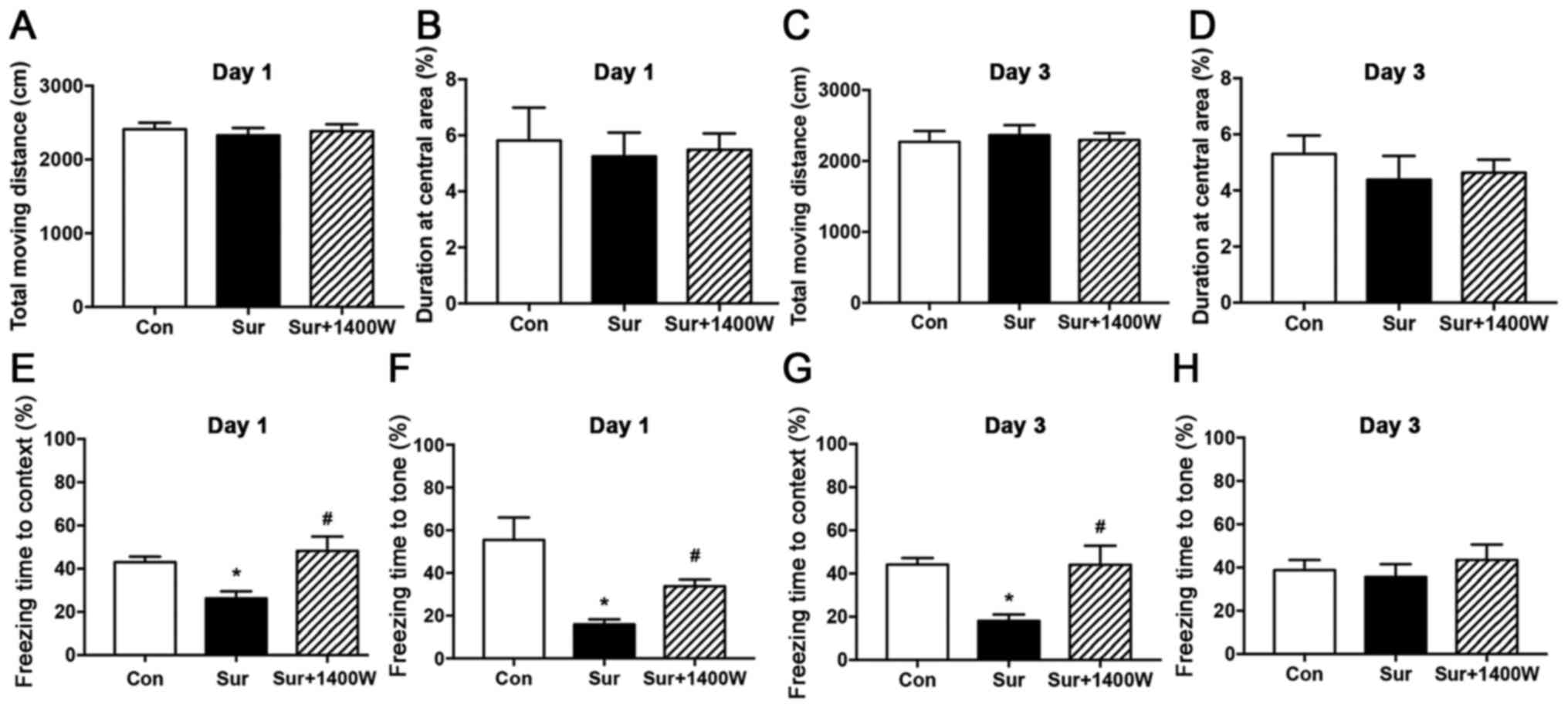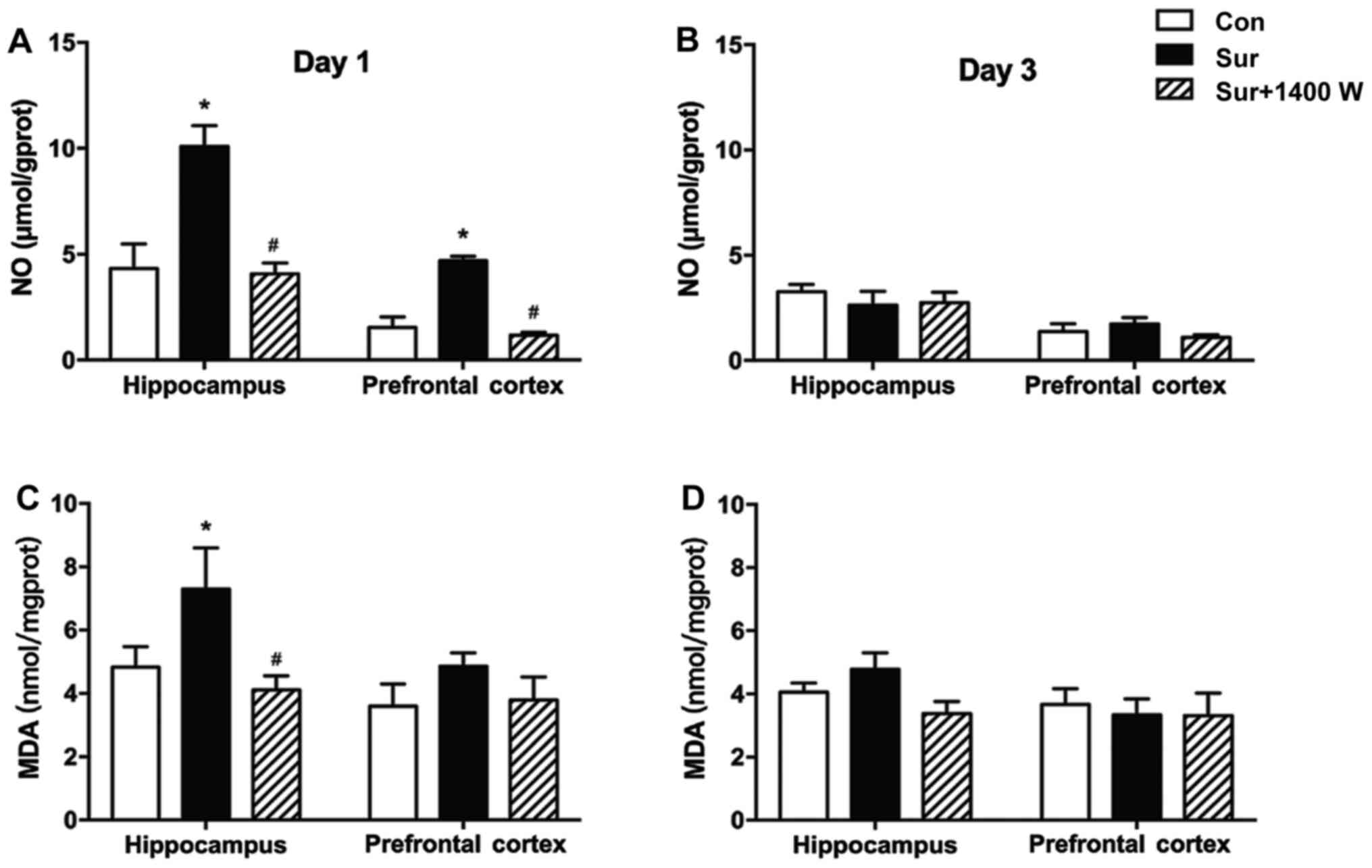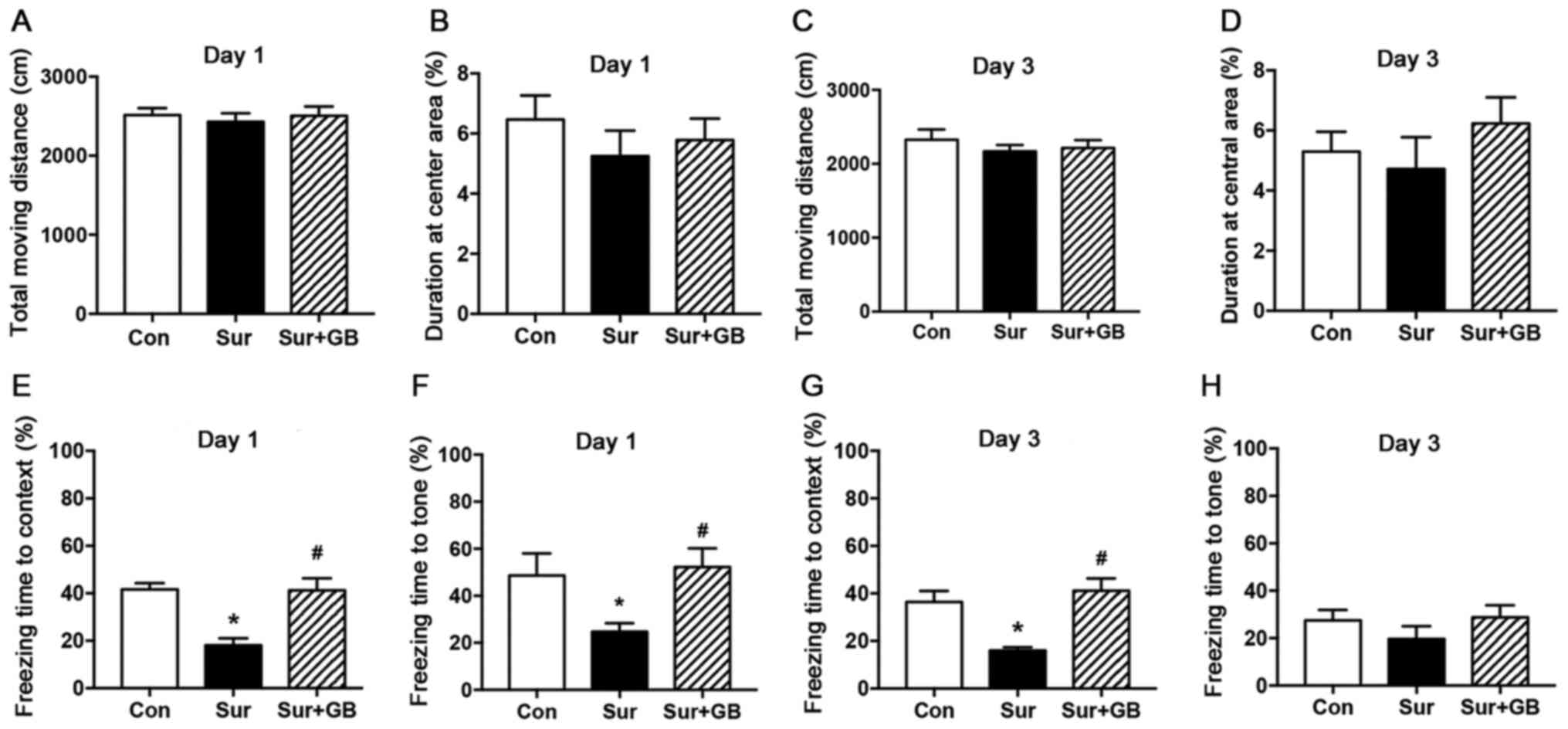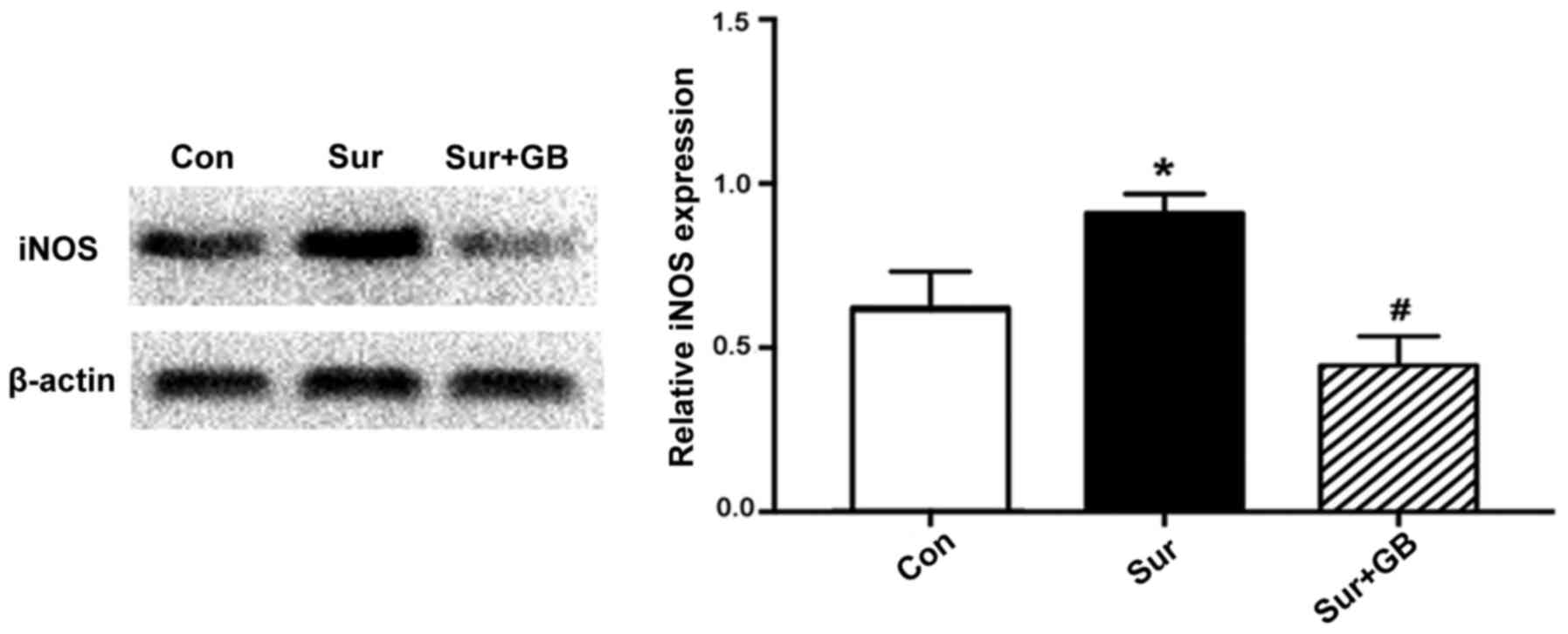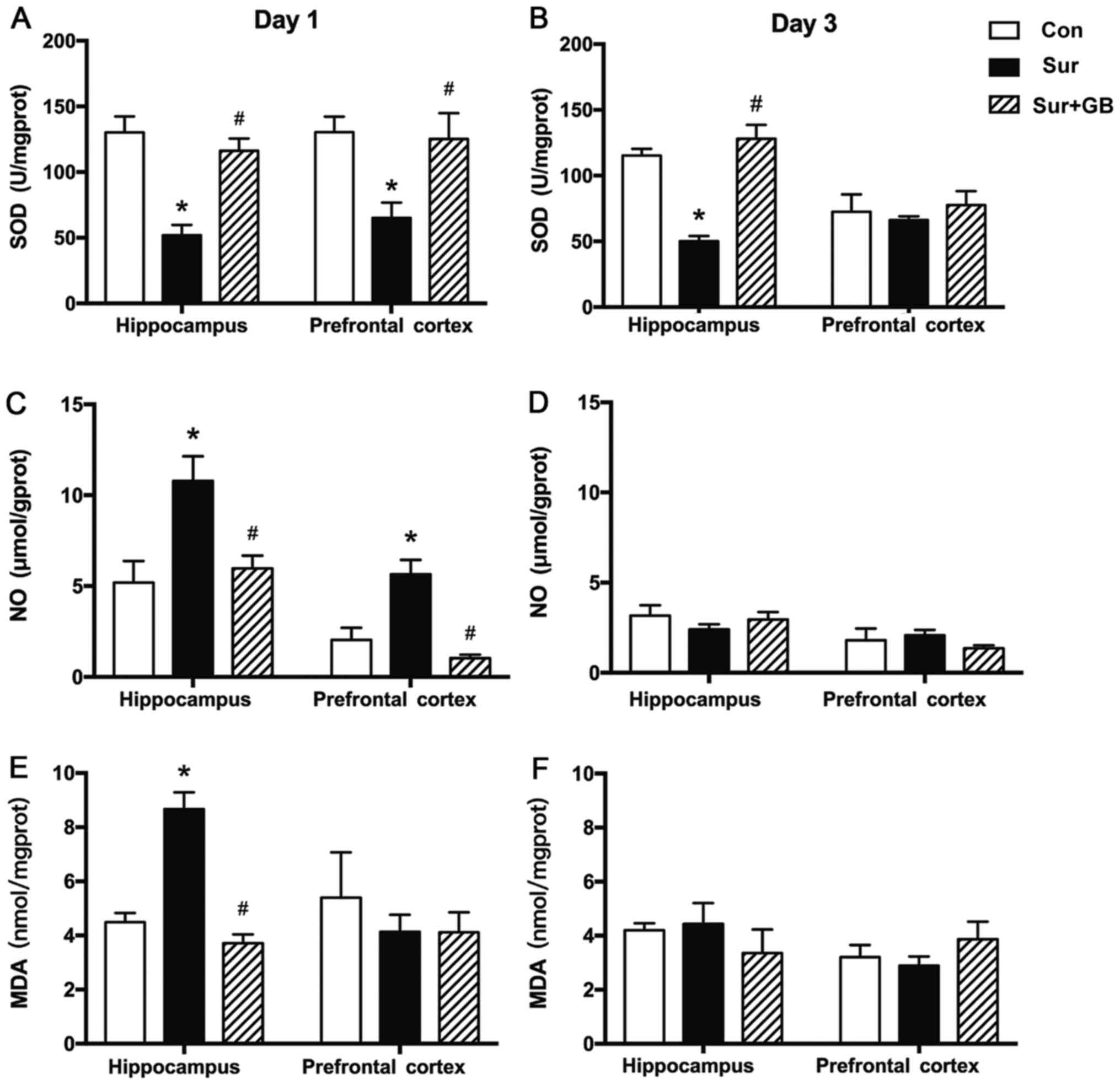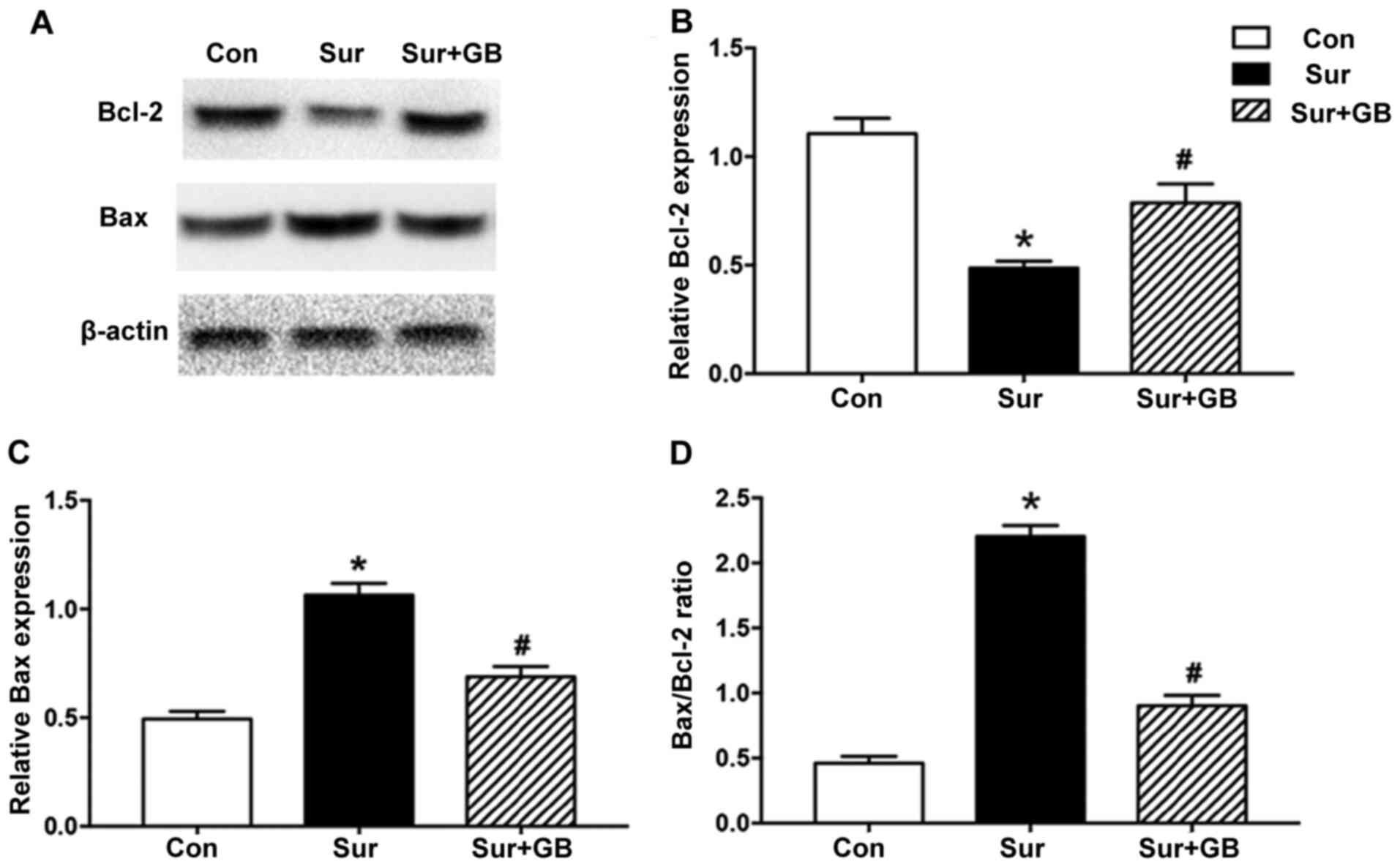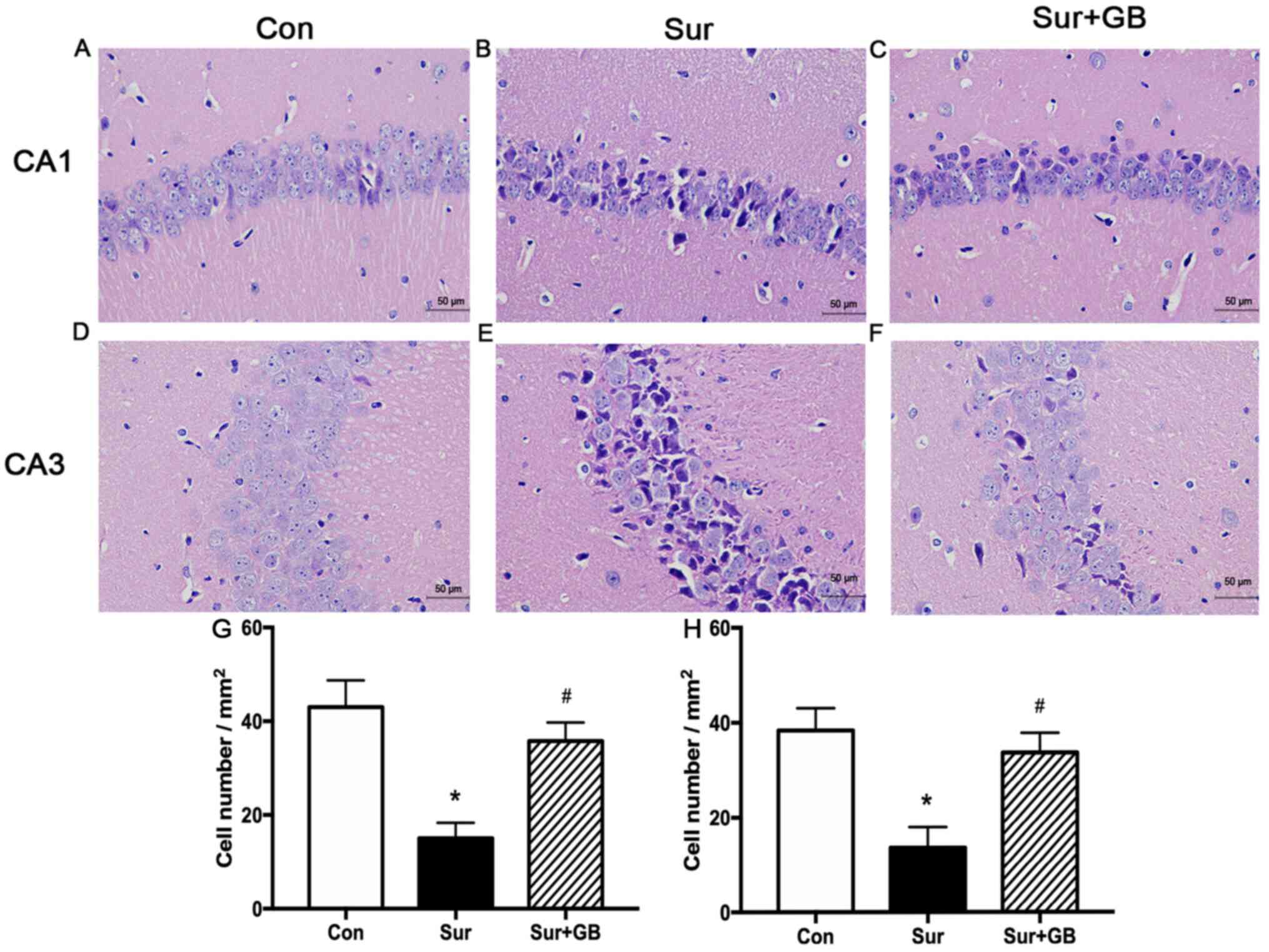|
1
|
Evered L, Silbert B, Knopman DS, Scott DA,
DeKosky ST, Rasmussen LS, Oh ES, Crosby G, Berger M and Eckenhoff
RG; Nomenclature Consensus Working Group, : Recommendations for the
nomenclature of cognitive change associated with anaesthesia and
surgery-2018. Anesthesiology. 129:872–879. 2018. View Article : Google Scholar : PubMed/NCBI
|
|
2
|
Huang S, Hu H, Cai YH and Hua F: Effect of
parecoxib in the treatment of postoperative cognitive dysfunction:
A systematic review and meta-analysis. Medicine (Baltimore).
98:e138122019. View Article : Google Scholar : PubMed/NCBI
|
|
3
|
Androsova G, Krause R, Winterer G and
Schneider R: Biomarkers of postoperative delirium and cognitive
dysfunction. Front Aging Neurosci. 7:1122015. View Article : Google Scholar : PubMed/NCBI
|
|
4
|
Netto MB, de Oliveira Junior AN, Goldim M,
Mathias K, Fileti ME, da Rosa N, Laurentino AO, de Farias BX, Costa
AB, Rezin GT, et al: Oxidative stress and mitochondrial dysfunction
contributes to postoperative cognitive dysfunction in elderly rats.
Brain Behav Immun. 73:661–669. 2018. View Article : Google Scholar : PubMed/NCBI
|
|
5
|
Zhang J, Gao J, Guo G, Li S, Zhan G, Xie
Z, Yang C and Luo A: Anesthesia and surgery induce delirium-like
behavior in susceptible mice: The role of oxidative stress. Am J
Transl Res. 10:2435–2444. 2018.PubMed/NCBI
|
|
6
|
Dröge W: Free radicals in the
physiological control of cell function. Physiol Rev. 82:47–95.
2002. View Article : Google Scholar
|
|
7
|
Venturelli M, Pedrinolla A, Boscolo
Galazzo I, Fonte C, Smania N, Tamburin S, Muti E, Crispoltoni L,
Stabile A, Pistilli A, et al: Impact of nitric oxide
bioavailability on the progressive cerebral and peripheral
circulatory impairments during aging and Alzheimer's disease. Front
Physiol. 9:1692018. View Article : Google Scholar : PubMed/NCBI
|
|
8
|
Stephan BCM, Harrison SL, Keage HAD,
Babateen A, Robinson L and Siervo M: Cardiovascular disease, the
nitric oxide pathway and risk of cognitive impairment and dementia.
Curr Cardiol Rep. 19:872017. View Article : Google Scholar : PubMed/NCBI
|
|
9
|
Tse JKY: Gut microbiota, nitric oxide, and
microglia as prerequisites for neurodegenerative disorders. ACS
Chem Neurosci. 8:1438–1447. 2017. View Article : Google Scholar : PubMed/NCBI
|
|
10
|
Takahashi M, Chin Y, Nonaka T, Hasegawa M,
Watanabe N and Arai T: Prolonged nitric oxide treatment induces tau
aggregation in SH-SY5Y cells. Neurosci Lett. 510:48–52. 2012.
View Article : Google Scholar : PubMed/NCBI
|
|
11
|
Chinta SJ and Andersen JK: Nitrosylation
and nitration of mitochondrial complex I in Parkinson's disease.
Free Radic Res. 45:53–58. 2011. View Article : Google Scholar : PubMed/NCBI
|
|
12
|
Asiimwe N, Yeo SG, Kim MS, Jung J and
Jeong NY: Nitric oxide: Exploring the contextual link with
Alzheimer's disease. Oxid Med Cell Longev. 2016:72057472016.
View Article : Google Scholar : PubMed/NCBI
|
|
13
|
Zhang Y, Xiong S, Liu P, Liu W, Wang Q,
Liu Y, Tan H, Chen X, Shi X, Wang Q and Chen T: Polymeric
nanoparticles-based brain delivery with improved therapeutic
efficacy of ginkgolide B in Parkinson's disease. Int J
Nanomedicine. 15:10453–10467. 2020. View Article : Google Scholar : PubMed/NCBI
|
|
14
|
Sharma HS, Drieu K, Alm P and Westman J:
Role of nitric oxide in blood-brain barrier permeability, brain
edema and cell damage following hyperthermic brain injury. An
experimental study using EGB-761 and Gingkolide B pretreatment in
the rat. Acta Neurochir Suppl. 76:81–86. 2000.PubMed/NCBI
|
|
15
|
Liu Q, Jin Z, Xu Z, Yang H, Li L, Li G, Li
F, Gu S, Zong S, Zhou J, et al: Antioxidant effects of ginkgolides
and bilobalide against cerebral ischemia injury by activating the
Akt/Nrf2 pathway in vitro and in vivo. Cell Stress Chaperones.
24:441–452. 2019. View Article : Google Scholar : PubMed/NCBI
|
|
16
|
Deng Y, Fang W, Li Y, Cen J, Fang F, Lv P,
Gong S and Mao L: Blood-brain barrier breakdown by PAF and
protection by XQ-1H due to antagonism of PAF effects. Eur J
Pharmacol. 616:43–47. 2009. View Article : Google Scholar : PubMed/NCBI
|
|
17
|
Gu JH, Ge JB, Li M, Wu F, Zhang W and Qin
ZH: Inhibition of NF-κB activation is associated with
anti-inflammatory and anti-apoptotic effects of ginkgolide B in a
mouse model of cerebral ischemia/reperfusion injury. Eur J Pharm
Sci. 47:652–660. 2012. View Article : Google Scholar : PubMed/NCBI
|
|
18
|
Fang W, Sha L, Kodithuwakku ND, Wei J,
Zhang R, Han D, Mao L and Li Y: Attenuated blood-brain barrier
dysfunction by XQ-1H following ischemic stroke in hyperlipidemic
rats. Mol Neurobiol. 52:162–175. 2015. View Article : Google Scholar : PubMed/NCBI
|
|
19
|
Rosczyk HA, Sparkman NL and Johnson RW:
Neuroinflammation and cognitive function in aged mice following
minor surgery. Exp Gerontol. 43:840–846. 2008. View Article : Google Scholar : PubMed/NCBI
|
|
20
|
Tian XS, Tong YW, Li ZQ, Li LX, Zhang T,
Ren TY, Zhou T, Wang HC, Zhan R, Sun Y, et al: Surgical stress
induces brain-derived neurotrophic factor reduction and
postoperative cognitive dysfunction via glucocorticoid receptor
phosphorylation in aged mice. CNS Neurosci Ther. 21:398–409. 2015.
View Article : Google Scholar : PubMed/NCBI
|
|
21
|
Seibenhener ML and Wooten MC: Use of the
open field maze to measure locomotor and anxiety-like behavior in
mice. J Vis Exp. 6:e524342015.PubMed/NCBI
|
|
22
|
Zhang Z, Li X, Li F and An L: Berberine
alleviates postoperative cognitive dysfunction by suppressing
neuroinflammation in aged mice. Int Immunopharmacol. 38:426–433.
2016. View Article : Google Scholar : PubMed/NCBI
|
|
23
|
Saxe MD, Battaglia F, Wang JW, Malleret G,
David DJ, Monckton JE, Garcia AD, Sofroniew MV, Kandel ER,
Santarelli L, et al: Ablation of hippocampal neurogenesis impairs
contextual fear conditioning and synaptic plasticity in the dentate
gyrus. Proc Natl Acad Sci USA. 103:17501–17506. 2006. View Article : Google Scholar : PubMed/NCBI
|
|
24
|
Xu Z, Dong Y, Wang H, Culley DJ,
Marcantonio ER, Crosby G, Tanzi RE, Zhang Y and Xie Z:
Age-dependent postoperative cognitive impairment and
Alzheimer-related neuropathology in mice. Sci Rep. 4:37662014.
View Article : Google Scholar : PubMed/NCBI
|
|
25
|
Winocur G, Wojtowicz JM, Sekeres M, Snyder
JS and Wang S: Inhibition of neurogenesis interferes with
hippocampus-dependent memory function. Hippocampus. 16:296–304.
2006. View Article : Google Scholar : PubMed/NCBI
|
|
26
|
Korsmeyer SJ, Shutter JR, Veis DJ, Merry
DE and Oltvai ZN: Bcl-2/Bax: A rheostat that regulates an
anti-oxidant pathway and cell death. Semin Cancer Biol. 4:327–332.
1993.PubMed/NCBI
|
|
27
|
Hovens IB, van Leeuwen BL, Mariani MA,
Kraneveld AD and Schoemaker RG: Postoperative cognitive dysfunction
and neuroinflammation; cardiac surgery and abdominal surgery are
not the same. Brain Behav Immun. 54:178–193. 2016. View Article : Google Scholar : PubMed/NCBI
|
|
28
|
Monk TG, Weldon BC, Garvan CW, Dede DE,
van der Aa MT, Heilman KM and Gravenstein JS: Predictors of
cognitive dysfunction after major noncardiac surgery.
Anesthesiology. 108:18–30. 2008. View Article : Google Scholar : PubMed/NCBI
|
|
29
|
Shu AH, Wang Q and Chen XB: Effect of
different depths of anesthesia on postoperative cognitive function
in laparoscopic patients: A randomized clinical trial. Curr Med Res
Opin. 31:1883–1887. 2015. View Article : Google Scholar : PubMed/NCBI
|
|
30
|
Xiong C, Liu J, Lin D, Zhang J, Terrando N
and Wu A: Complement activation contributes to perioperative
neurocognitive disorders in mice. J Neuroinflammation. 15:2542018.
View Article : Google Scholar : PubMed/NCBI
|
|
31
|
Zhang J, Zhu S, Jin P, Huang Y, Dai Q, Zhu
Q, Wei P, Yang Z, Zhang L, Liu H, et al: Graphene oxide improves
postoperative cognitive dysfunction by maximally alleviating
amyloid beta burden in mice. Theranostics. 10:11908–11920. 2020.
View Article : Google Scholar : PubMed/NCBI
|
|
32
|
Sun L, Dong R, Xu X, Yang X and Peng M:
Activation of cannabinoid receptor type 2 attenuates
surgery-induced cognitive impairment in mice through
anti-inflammatory activity. J Neuroinflammation. 14:1382017.
View Article : Google Scholar : PubMed/NCBI
|
|
33
|
Zhou XY, Zhang F, Ying CJ, Chen J, Chen L,
Dong J, Shi Y, Tang M, Hu XT, Pan ZH, et al: Inhibition of iNOS
alleviates cognitive deficits and depression in diabetic mice
through downregulating the NO/sGC/cGMP/PKG signal pathway. Behav
Brain Res. 322:70–82. 2017. View Article : Google Scholar : PubMed/NCBI
|
|
34
|
Clausen A, Doctrow S and Baudry M:
Prevention of cognitive deficits and brain oxidative stress with
superoxide dismutase/catalase mimetics in aged mice. Neurobiol
Aging. 31:425–433. 2010. View Article : Google Scholar : PubMed/NCBI
|
|
35
|
Greilberger J, Koidl C, Greilberger M,
Lamprecht M, Schroecksnadel K, Leblhuber F, Fuchs D and Oettl K:
Malondialdehyde, carbonyl proteins and albumin-disulphide as useful
oxidative markers in mild cognitive impairment and Alzheimer's
disease. Free Radic Res. 42:633–638. 2008. View Article : Google Scholar : PubMed/NCBI
|
|
36
|
Shi Q, Liu X, Wang N, Zheng X, Ran J, Liu
Z, Fu J and Zheng J: 1400W ameliorates acute hypobaric
hypoxia/reoxygenation-induced cognitive deficits by suppressing the
induction of inducible nitric oxide synthase in rat cerebral cortex
microglia. Behav Brain Res. 319:188–199. 2017. View Article : Google Scholar : PubMed/NCBI
|
|
37
|
Moldogazieva NT, Mokhosoev IM, Feldman NB
and Lutsenko SV: ROS and RNS signalling: Adaptive redox switches
through oxidative/nitrosative protein modifications. Free Radic
Res. 52:507–543. 2018. View Article : Google Scholar : PubMed/NCBI
|
|
38
|
Chitnis T and Weiner HL: CNS inflammation
and neurodegeneration. J Clin Invest. 127:3577–3587. 2017.
View Article : Google Scholar : PubMed/NCBI
|
|
39
|
Hemanth Kumar K, Tamatam A, Pal A and
Khanum F: Neuroprotective effects of cyperus rotundus on SIN-1
induced nitric oxide generation and protein nitration: Ameliorative
effect against apoptosis mediated neuronal cell damage.
Neurotoxicology. 34:150–159. 2013. View Article : Google Scholar : PubMed/NCBI
|
|
40
|
Ranjan R, Karpurapu M, Rani A, Chishti AH
and Christman JW: Hemozoin regulates iNOS expression by modulating
the transcription factor NF-κB in macrophages. Biochem Mol Biol J.
2:102016. View Article : Google Scholar : PubMed/NCBI
|
|
41
|
Woo CW, Cheung F, Chan VW, Siow YL and O
K: Homocysteine stimulates inducible nitric oxide synthase
expression in macrophages: Antagonizing effect of ginkgolides and
bilobalide. Mol Cell Biochem. 243:37–47. 2003. View Article : Google Scholar : PubMed/NCBI
|
|
42
|
Gill I, Kaur S, Kaur N, Dhiman M and
Mantha AK: Phytochemical ginkgolide B attenuates amyloid-β1-42
induced oxidative damage and altered cellular responses in human
neuroblastoma SH-SY5Y Cells. J Alzheimers Dis. 60 (Suppl
1):S25–S40. 2017. View Article : Google Scholar : PubMed/NCBI
|
|
43
|
Li W, Qinghai S, Kai L, Xue M, Lili N,
Jihua R, Zhengxiang L, Xiaoling L, Di G, Qi Y, et al: Oral
administration of ginkgolide B alleviates hypoxia-induced neuronal
damage in rat hippocampus by inhibiting oxidative stress and
apoptosis. Iran J Basic Med Sci. 22:140–145. 2019.PubMed/NCBI
|
|
44
|
Qian XL, Zhang W, Liu MZ, Zhou YB, Zhang
JM, Han L, Peng YM, Jiang JH and Wang QD: Dexmedetomidine improves
early postoperative cognitive dysfunction in aged mice. Eur J
Pharmacol. 746:206–212. 2015. View Article : Google Scholar : PubMed/NCBI
|















